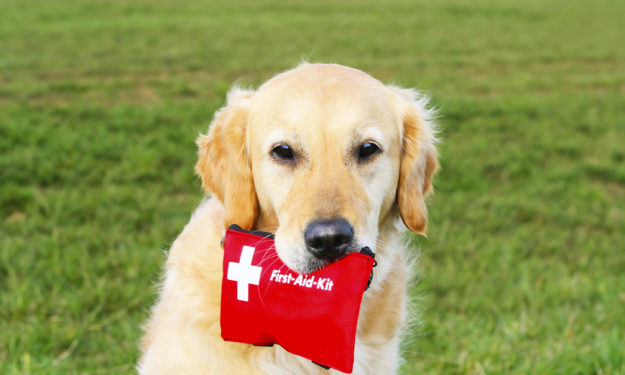Four-Legged First Aid Know How

Since animals cannot use 911 service, the numbers of your primary care veterinarian and animal emergency center should be readily available. Pet sitters should know where to find these numbers in your absence. When traveling with your pet, identify a local veterinarian or emergency care facility to use if necessary. For questions about ingestion of a toxic substance, the Animal Poison Control Center 1-888-426-4435, is available 24/7. They provide valuable information to help your veterinarian in treating specific types of chemical, plant, and medication exposures.
Know how to recognize when your pet needs emergency care. Be familiar with ‘normal’ for your animal. The heart rate is felt near the point where the left elbow touches the rib cage. The pulse is found on the middle of the inner thigh a few inches below the groin. The oral membranes (inside of lip and gums) should be medium pink and moist.
Some symptoms are easy to identify – visible bleeding or swelling, labored breathing, tremors, collapse, difficulty walking, vomiting, diarrhea, straining to urinate. Other signs can be more subtle: anxiety or pacing, lethargy or confusion, significant variations from normal body temperature, heart rates and breathing patterns, oral membranes that appear pale, gray or blue.
Know how to stabilize your pet until veterinary care is obtained. Anyone familiar with first aid as taught by the American Red Cross will recognize the ABCs – maintaining an airway, breathing and circulation. Core principles of first aid that are given to a human are the same as those for a small animal. Apply direct pressure onto bleeding wounds. If your pet is not breathing, look in the mouth for any foreign object that may be blocking the airway. Remove it if it is completely stopping breathing. If there is no object and the animal is not breathing, hold the muzzle closed and forcefully blow air (4-5 breaths) into the animal’s nose. Repeat until he/she is breathing normally. Begin chest compressions only if there is no heartbeat. There should be 3-5 chest compressions for each artificial breath.
A key difference in providing care to an animal is to avoid being injured by the patient. The most docile animals can react aggressively when painful or afraid. Keeping yourself and your pet calm could be the most difficult task in an emergency situation. If necessary, place a muzzle over the mouth before attempting to move a patient or examine a wound. A towel or blanket can be used as a sling to assist in walking, as a stretcher to help move an animal or to loosely swaddle cats to prevent biting and scratching.
Normal Ranges:
Temperature: Dogs and cats 100-102.5 degrees Fahrenheit
Heart Rate: Small dogs (under 30 pounds) 100-160 bpm; medium to large dogs (over 30 pounds) 60-100 bpm; puppies (until 1 year old) 120-160 bpm; cats 130-220 bpm
Respiratory rate: Dogs 10-30 breaths/min; cats 20-30 breaths/min (panting or open mouth breathing in a cat needs immediate attention)
These are basic tenets to follow in any scenario. The best way to handle an emergency is to be prepared.